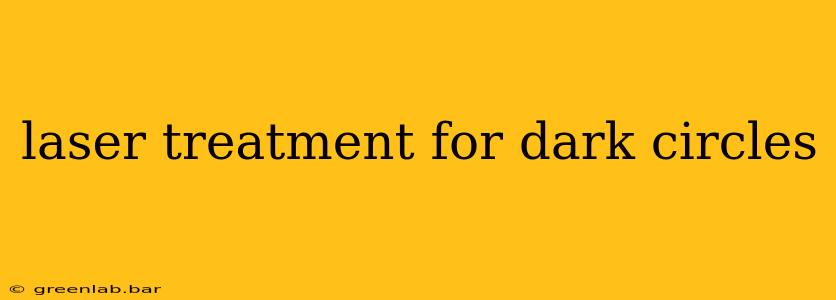Dark circles under the eyes can be a frustrating cosmetic concern, impacting self-esteem and overall appearance. While makeup can provide temporary camouflage, many seek more permanent solutions. Laser treatment has emerged as a popular option, offering potential improvements in the appearance of dark circles. This comprehensive guide explores laser treatment for dark circles, its effectiveness, potential risks, and what to expect during and after the procedure.
Understanding the Causes of Dark Circles
Before delving into treatment options, it's crucial to understand the root causes of dark circles. These can vary significantly, influencing the best course of action. Common causes include:
- Hyperpigmentation: Increased melanin production leads to darker skin under the eyes. This is often genetic or triggered by sun exposure.
- Thin Skin: The delicate skin under the eyes can become thinner with age, revealing underlying blood vessels and causing a bluish or purplish discoloration.
- Vascular Issues: Dilated blood vessels under the skin can contribute to the dark circles' appearance.
- Genetics: Family history significantly influences the likelihood of developing dark circles.
- Lack of Sleep: Insufficient sleep can exacerbate the appearance of dark circles due to increased blood vessel visibility.
- Dehydration: Dehydration can lead to a dull, sunken look, making dark circles appear more prominent.
Types of Laser Treatments for Dark Circles
Several laser treatments target different aspects of dark circles:
1. Nd:YAG Laser:
This laser targets the blood vessels contributing to the dark circles' bluish hue. By reducing vascular congestion, it can improve the overall appearance of the under-eye area.
2. Fraxel Laser:
Fraxel lasers stimulate collagen production, which can help improve skin texture and reduce the appearance of wrinkles and fine lines often associated with dark circles. It also addresses hyperpigmentation.
3. IPL (Intense Pulsed Light):
IPL therapy uses broad-spectrum light to target both hyperpigmentation and vascular issues contributing to dark circles. It's often a gentler option than some laser treatments.
What to Expect During and After Laser Treatment
The procedure itself is usually quick and relatively comfortable, with a topical anesthetic often used to minimize discomfort. The number of sessions needed varies depending on the individual and the severity of the dark circles.
Post-treatment: You might experience some redness, swelling, or mild discomfort for a few days. Your dermatologist will provide specific aftercare instructions, likely including:
- Avoiding sun exposure: Sunscreen is crucial to protect the treated area and prevent hyperpigmentation.
- Gentle cleansing: Avoid harsh scrubbing or exfoliation.
- Keeping the area moisturized: Use a gentle moisturizer recommended by your dermatologist.
Effectiveness and Potential Risks
Laser treatments for dark circles can be effective for many individuals, particularly those with hyperpigmentation or vascular issues. However, it's important to remember that results vary, and not everyone experiences complete resolution of dark circles.
Potential risks include:
- Temporary redness and swelling
- Hyperpigmentation or hypopigmentation (changes in skin color)
- Infection
- Scarring (rare)
It's essential to consult a qualified and experienced dermatologist to determine if laser treatment is suitable for you and to discuss the potential risks and benefits.
Choosing a Qualified Dermatologist
Selecting a board-certified dermatologist with extensive experience in laser treatments is crucial. Look for a dermatologist with a strong track record and positive patient reviews. During your consultation, discuss your concerns, medical history, and expectations realistically.
Conclusion: A Holistic Approach
While laser treatments can significantly improve the appearance of dark circles, it's important to adopt a holistic approach. Maintaining a healthy lifestyle, including adequate sleep, hydration, and sun protection, can complement the effects of laser treatment and contribute to healthier, brighter skin around the eyes. Remember, realistic expectations and careful consultation with a qualified dermatologist are key to achieving the desired results.

